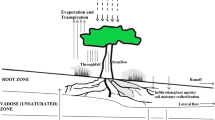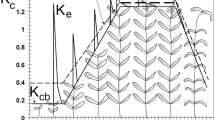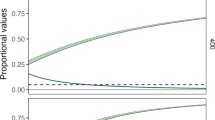Abstract
Key message
The novel approach for direct parameterization of the Penman–Monteith equation was developed to compute diurnal courses of stand canopy conductance from sap flow.
Abstract
The Penman–Monteith equation of evaporation is often combined with sap flow measurements to describe canopy transpiration and stomatal conductance. The traditional approach involves a two-step calculation. In the first step, stomatal conductance is computed using an inverted form of Penman–Monteith equation. The second step correlates these values with environmental factors. In this work, we present an improved approach for direct parameterization of the Penman–Monteith equation developed to compute diurnal courses of stand canopy conductance (g c) from sap flow. The main advantages of this proposed approach versus using the classical approach are: (1) the calculation process is faster and involves fewer steps, (2) parameterization provides realistic values of canopy conductance, including conditions of low atmospheric vapor pressure deficit (D), whereas the traditional approach tends to yield unrealistic values for low D and (3) the new calculation method does not require enveloping curves to describe dependence of g c on D and thus avoids subjective data selection but it still allows to visualize separable responses of g c to environmental drivers (i.e., global radiation and vapor pressure deficit). The proposed approach was tested to calculate g c and to model the sap flow of a high mountain Pinus canariensis forest. The new calculation method permitted us to describe the stand canopy conductance and stand sap flow in sub-hour resolution for both day and night conditions. Direct parameterization of the Penman–Monteith approach as implemented in this study proved sufficiently sensitive for detecting diurnal variation in g c and for predicting sap flow from environmental variables under various atmospheric evapotranspirative demands and differing levels of soil water availability.






Similar content being viewed by others
References
Addington R, Mitchell R, Oren R, Donovan L (2004) Stomatal sensitivity to vapor pressure deficit and its relationship to hydraulic conductance in Pinus palustris. Tree Physiol 24:561–569
Anfodillo T, Rento S, Carraro V et al (1998) Tree water relations and climatic variations at the alpine timberline: seasonal changes of sap flux and xylem water potential in Larix decidua Miller, Picea abies (L.) Karst. and Pinus cembra L. Ann For Sci 55:159–172
Aphalo P, Jarvis P (1991) Do stomata respond to relative humidity? Plant Cell Environ 14:127–132
Ball J, Woodrow I, Berry J (1987) A model predicting stomatal conductance and its contribution to the control of photosynthesis under different environmental conditions. Prog Photosynth Res IV:221–224
Berry JA, Beerling DJ, Franks PJ (2010) Stomata: key players in the earth system, past and present. Curr Opin Plant Biol 13:233–240. doi:10.1016/j.pbi.2010.04.013
Bohrer G, Mourad H, Laursen TA et al (2005) Finite element tree crown hydrodynamics model (FETCH) using porous media flow within branching elements: a new representation of tree hydrodynamics. Water Resour Res 41:1–17. doi:10.1029/2005WR004181
Bonan GB, Williams M, Fisher RA, Oleson KW (2014) Modeling stomatal conductance in the earth system: linking leaf water-use efficiency and water transport along the soil–plant–atmosphere continuum. Geosci Model Dev 7:2193–2222. doi:10.5194/gmd-7-2193-2014
Bourne AE, Haigh AM, Ellsworth DS (2015) Stomatal sensitivity to vapour pressure deficit relates to climate of origin in Eucalyptus species. Tree Physiol 35:266–278. doi:10.1093/treephys/tpv014
Braun S, Schindler C, Leuzinger S (2010) Use of sap flow measurements to validate stomatal functions for mature beech (Fagus sylvatica) in view of ozone uptake calculations. Environ Pollut 158:2954–2963. doi:10.1016/j.envpol.2010.05.028
Brito P, Lorenzo JR, González-Rodríguez ÁM et al (2014) Canopy transpiration of a Pinus canariensis forest at the tree line: implications for its distribution under predicted climate warming. Eur J For Res 133:491–500. doi:10.1007/s10342-014-0779-5
Brito P, Lorenzo JR, González-rodríguez ÁM et al (2015) Canopy transpiration of a semi arid Pinus canariensis forest at a treeline ecotone in two hydrologically contrasting years. Agric For Meteorol 201:120–127. doi:10.1016/j.agrformet.2014.11.008
Buckley TN, Mott KA (2013) Modelling stomatal conductance in response to environmental factors. Plant Cell Environ 36:1691–1699. doi:10.1111/pce.12140
Buckley TN, Turnbull TL, Adams MA (2012) Simple models for stomatal conductance derived from a process model: cross-validation against sap flux data. Plant Cell Environ 35:1647–1662. doi:10.1111/j.1365-3040.2012.02515.x
Burghardt M, Riederer M (2003) Ecophysiological relevance of cuticular transpiration of deciduous and evergreen plants in relation to stomatal closure and leaf water potential. J Exp Bot 54:1941–1949. doi:10.1093/jxb/erg195
Caird M, Richards J, Donovan L (2007) Nighttime stomatal conductance and transpiration in C3 and C4 plants. Plant Physiol 143:4–10. doi:10.1104/pp.106.092940
Carrasco LO, Bucci SJ, Di Francescantonio D et al (2015) Water storage dynamics in the main stem of subtropical tree species differing in wood density, growth rate and life history traits. Tree Physiol 35:354–365. doi:10.1093/treephys/tpu087
Čermák J, Deml M, Penka M (1973) A new method of sap flow rate determination in trees. Biol Plant 15:171–178
Čermák J, Kučera J, Nadezhdina N (2004) Sap flow measurements with some thermodynamic methods, flow integration within trees and scaling up from sample trees to entire forest stands. Trees 18:529–546. doi:10.1007/s00468-004-0339-6
Čermák J, Kučera J, Bauerle WL et al (2007) Tree water storage and its diurnal dynamics related to sap flow and changes in stem volume in old-growth Douglas-fir trees. Tree Physiol 27:181–198
Chuang Y, Oren R, Bertozzi AL et al (2006) The porous media model for the hydraulic system of a conifer tree: linking sap flux data to transpiration rate. Ecol Modell 191:447–468. doi:10.1016/j.ecolmodel.2005.03.027
Cienciala E, Kučera J, Lindroth A et al (1997) Canopy transpiration from a boreal forest in Sweden during a dry year. Agric For Meteorol 86:157–167. doi:10.1016/S0168-1923(97)00026-9
Collatz GJ, Ball JT, Grivet C, Berry JA (1991) Physiological and environmental regulation of stomatal conductance, photosynthesis and transpiration: a model that includes a laminar boundary layer. Agric For Meteorol 54:107–136. doi:10.1016/0168-1923(91)90002-8
Egea G, Verhoef A, Vidale PL (2011) Towards an improved and more flexible representation of water stress in coupled photosynthesis-stomatal conductance models. Agric For Meteorol 151:1370–1384. doi:10.1016/j.agrformet.2011.05.019
Ewers BE, Oren R (2000) Analyses of assumptions and errors in the calculation of stomatal conductance from sap flux measurements. Tree Physiol 20:579–589
Ewers BE, Mackay DS, Samanta S (2007a) Interannual consistency in canopy stomatal conductance control of leaf water potential across seven tree species. Tree Physiol 27:11–24. doi:10.1093/treephys/27.1.11
Ewers BE, Oren R, Kim H et al (2007b) Effects of hydraulic architecture and spatial variation in light on mean stomatal conductance of tree branches. Plant Cell Environ 30:483–496. doi:10.1111/j.1365-3040.2007.01636.x
Fernández-Palacios J, de Nicolás J (1995) Altitudal pattern of vegetation variation on tenerife. J Veg Sci 6:183–190
Fu S, Sun L, Luo Y (2016) Combining sap flow measurements and modelling to assess water needs in an oasis farmland shelterbelt of Populus simonii Carr in Northwest China. Agric Water Manag 177:172–180. doi:10.1016/j.agwat.2016.07.015
García-Santos G, Bruijnzeel LA, Dolman AJ (2009) Modelling canopy conductance under wet and dry conditions in a subtropical cloud forest. Agric For Meteorol 149:1565–1572. doi:10.1016/j.agrformet.2009.03.008
Gieger T, Leuschner C (2004) Altitudinal change in needle water relations of Pinus canariensis and possible evidence of a drought-induced alpine timberline on Mt. Teide, Tenerife. Flora 109:100–109
Granier A, Loustau D (1994) Measuring and modelling the transpiration of a maritime pine canopy from sap-flow data. Agric For Meteorol 71:61–81
Granier A, Reichstein M, Bréda N et al (2007) Evidence for soil water control on carbon and water dynamics in European forests during the extremely dry year: 2003. Agric For Meteorol 143:123–145
Harris P, Huntingford C, Cox PM et al (2004) Effect of soil moisture on canopy conductance of Amazonian rainforest. Agric For Meteorol 122:215–227. doi:10.1016/j.agrformet.2003.09.006
Hernandez-Santana V, Fernández J, Rodriguez-Dominguez C et al (2016) The dynamics of radial sap flux density reflects changes in stomatal conductance in response to soil and air water deficit. Agric For Meteorol 219:92–101
Irvine J, Grace J (1997) Continuous measurements of water tensions in the xylem of trees based on the elastic properties of wood. Planta 202:455–461. doi:10.1007/s00425005014
Janott M, Gayler S, Gessler A et al (2011) A one-dimensional model of water flow in soil-plant systems based on plant architecture. Plant Soil 341:233–256. doi:10.1007/s11104-010-0639-0
Jarvis PG (1976) The interpretation of the variations in leaf water potential and stomatal conductance found in canopies in the field. Philos Trans R Soc B Biol Sci 273:593–610. doi:10.1098/rstb.1976.0035
Jarvis AJ, Davies WJ (1998) The coupled response of stomatal conductance to photosynthesis and transpiration. J Exp Bot 49:399–406
Jarvis P, McNaughton K (1986) Stomatal control of transpiration: scaling up from leaf to region. Adv Ecol Res 15:1–49
Jones HG (2014) Plants and microclimate. A quantitative approach to environmental plant physiology. doi:10.1017/CBO9781107415324.004
Kavanagh KL, Pangle R, Schotzko AD (2007) Nocturnal transpiration causing disequilibrium between soil and stem predawn water potential in mixed conifer forests of Idaho. Tree Physiol 27:621–629
Kučera J, Čermák J, Penka M (1977) Improved thermal method of continual recording the transpiration flow rate dynamics. Biol Plant 19:413–420
Langensiepen M, Fuchs M, Bergamaschi H et al (2009) Quantifying the uncertainties of transpiration calculations with the Penman–Monteith equation under different climate and optimum water supply conditions. Agric For Meteorol 149:1063–1072. doi:10.1016/j.agrformet.2009.01.001
Leuning R, Kelliher FM, De Pury DGG, Schulze ED (1995) Leaf nitrogen, photosynthesis, conductance and transpiration: scaling from leaves to canopies. Plant Cell Environ 18:1183–1200
Lohammar T, Larsson S, Linder S, Falk S (1980) FAST: simulation models of gaseous exchange in scots pine. Ecol Bull 32:505–523
Lu P, Biron P, Bréda N, Granier A (1995) Water relations of adult Norway spruce [Picea abies (L) Karst] under soil drought in the Vosges mountains: water potential, stomatal conductance and transpiration. Ann Sci For 52:117–129. doi:10.1051/forest:19950203
Luis V, Jimenez M, Morales D et al (2005) Canopy transpiration of a Canary Islands pine forest. Agric For Meteorol 135:117–123. doi:10.1016/j.agrformet.2005.11.009
Malone M (1993) Hydraulic signals. Philos Trans R Soc London Biol Sci 341:33–39
Martin T, Brown K, Cermak J et al (1997) Crown conductance and tree and stand transpiration in a second-growth Abies amabilis forest. Can J For Res 27:797–808
Matheny A, Bohrer G, Stoy P et al (2014a) Characterizing the diurnal patterns of errors in the prediction of evapotranspiration by several land-surface models: an NACP analysis. J Geophys Res 119:1458–1473. doi:10.1002/2014JG002623.Received
Matheny A, Bohrer G, Vogel C et al (2014b) Species-specific transpiration responses to intermediate disturbance in a northern hardwood forest. J Geophys Res Biogeosci 119:1–20. doi:10.1002/2014JG002804.Received
Matheny AM, Bohrer G, Garrity SR et al (2015) Observations of stem water storage in trees of opposing hydraulic strategies. Ecosphere 6:1–13. doi:10.1890/ES15-00170.1
Meinzer FC, Grantz DA (1990) Stomatal and hydraulic conductance in growing sugarcane-stomatal adjustment to water transport capacity. Plant Cell Environ 13:383–388
Meinzer FC, Andrade JL, Goldstein G et al (1997) Control of transpiration from the upper canopy of a tropical forest: the role of stomatal, boundary layer and hydraulic architecture components. Plant Cell Environ 20:1242–1252. doi:10.1046/j.1365-3040.1997.d01-26.x
Mirfenderesgi G, Bohrer G, Matheny AM et al (2016) Tree-level hydrodynamic approach for modeling aboveground water storage and stomatal conductance illuminates the effects of tree hydraulic strategy. J Geophys Res Biogeosciences 121:1792–1813. doi:10.1002/2016JG003467
Monteith JL (1965) Evaporation and environment. Symp Soc Exp Biol 19:205–234
Oguntunde P, Vandegiesen N, Savenije H (2007) Measurement and modelling of transpiration of a rain-fed citrus orchard under subhumid tropical conditions. Agric Water Manag 87:200–208. doi:10.1016/j.agwat.2006.06.019
Oren R, Sperry JS, Katul GG et al (1999) Survey and synthesis of intra- and interspecific variation in stomatal sensitivity to vapour pressure deficit. Plant Cell Environ 22:1515–1526. doi:10.1046/j.1365-3040.1999.00513.x
Oren R, Sperry J, Ewers B et al (2001) Sensitivity of mean canopy stomatal conductance to vapor pressure deficit in a flooded Taxodium distichum L. forest: hydraulic and non-hydraulic effects. Oecologia 126:21–29. doi:10.1007/s004420000497
Penman HL (1948) Natural evaporation from open water, bare soil and grass. Proc R Soc Lond A Math Phys Sci 193:120–145
Perämäki M, Nikinmaa E, Sevanto S et al (2001) Tree stem diameter variations and transpiration in Scots pine: an analysis using a dynamic sap flow model. Tree Physiol 21:889–897
Phillips N, Oren R (1998) A comparison of daily representations of canopy conductance based on two conditional time-averaging methods and the dependence of daily conductance on environmental factors. Ann Sci For 55:217–235. doi:10.1051/forest:19980113
Phillips N, Ryan M, Bond B et al (2003) Reliance on stored water increases with tree size in three species in the Pacific Northwest. Tree Physiol 23:237–245
Sack L, Holbrook NM (2006) Leaf hydraulics. Annu Rev Plant Biol 57:361–381. doi:10.1146/annurev.arplant.56.032604.144141
Schlesinger WH, Jasechko S (2014) Transpiration in the global water cycle. Agric For Meteorol 189–190:115–117. doi:10.1016/j.agrformet.2014.01.011
Shimazaki K, Doi M, Assmann SM, Kinoshita T (2007) Light regulation of stomatal movement. Annu Rev Plant Biol 58:219–247. doi:10.1146/annurev.arplant.57.032905.105434
Sommer R, Sáb TDDA, Vielhauera K et al (2002) Transpiration and canopy conductance of secondary vegetation in the eastern Amazon. Agric For Meteorol 112:103–121. doi:10.1016/S0168-1923(02)00044-8
Sperry JS, Adler FR, Campbell GS, Comstock JP (1998) Limitation of plant water use by rhizosphere and xylem conductance: results from a model. Plant Cell Environ 21:347–359. doi:10.1046/j.1365-3040.1998.00287.x
Steppe K, De Pauw DJW, Lemeur R, Vanrolleghem PA (2006) A mathematical model linking tree sap flow dynamics to daily stem diameter fluctuations and radial stem growth. Tree Physiol 26:257–273. doi:10.1093/treephys/26.3.257
Stewart J (1988) Modelling surface conductance of pine forest. Agric For Meteorol 43:19–35
Tardieu F, Davies WJ (1993) Integration of hydraulic and chemical signalling in the control of stomatal conductance and water status of droughted plants. Plant Cell Environ 16:341–349
Urban J, Čermák J, Ceulemans R (2015) Above- and below-ground biomass, surface and volume, and stored water in a mature Scots pine stand. Eur J For Res 134:61–74. doi:10.1007/s10342-014-0833-3
Verhoef A, Egea G (2014) Modeling plant transpiration under limited soil water: comparison of different plant and soil hydraulic parameterizations and preliminary implications for their use in land surface models. Agric For Meteorol 191:22–32. doi:10.1016/j.agrformet.2014.02.009
Wang H, Zhao P, Holscher D et al (2012) Nighttime sap flow of Acacia mangium and its implications for nighttime transpiration and stem water storage. J Plant Ecol 5:294–304. doi:10.1093/jpe/rtr025
Wang H, Guan H, Deng Z, Simmons CT (2014) Optimization of canopy conductance models from concurrent measurements of sap flow and stem water potential on Drooping Sheoak in South Australia. Water Resour Res 50:6154–6167. doi:10.1002/2013WR014818
Ward EJ, Oren R, Sigurdsson BD et al (2008) Fertilization effects on mean stomatal conductance are mediated through changes in the hydraulic attributes of mature Norway spruce trees. Tree Physiol 28:579–596
Ward EJ, Bell DM, Clark JS, Oren R (2013) Hydraulic time constants for transpiration of loblolly pine at a free-air carbon dioxide enrichment site. Tree Physiol 33:123–134. doi:10.1093/treephys/tps114
Warren JM, Meinzer FC, Brooks JR, Domec JC (2005) Vertical stratification of soil water storage and release dynamics in Pacific Northwest coniferous forests. Agric For Meteorol 130:39–58. doi:10.1016/j.agrformet.2005.01.004
Whitehead D (1998) Regulation of stomatal conductance and transpiration in forest canopies. Tree Physiol 18:633–644
Whitley R, Medlyn B, Zeppel M et al (2009) Comparing the Penman-Monteith equation and a modified Jarvis–Stewart model with an artificial neural network to estimate stand-scale transpiration and canopy conductance. J Hydrol 373:256–266. doi:10.1016/j.jhydrol.2009.04.036
Wieser G, Peters J, Luis VC et al (2002) Ecophysiological studies on the water relations in a Pinus canariensis stand, Tenerife, Canary Islands. Phyton (B Aires) 42:291–304
Wieser G, Luis VC, Cuevas E (2006) Quantification of ozone uptake at the stand level in a Pinus canariensis forest in Tenerife, Canary Islands: an approach based on sap flow measurements. Environ Pollut 140:383–386. doi:10.1016/j.envpol.2005.12.003
Xu X, Medvigy D, Powers JS et al (2016) Diversity in plant hydraulic traits explains seasonal and inter-annual variations of vegetation dynamics in seasonally dry tropical forests. New Phytol 212:80–95. doi:10.1111/nph.14009
Zeppel MJB, Lewis JD, Chaszar B et al (2011) Nocturnal stomatal conductance responses to rising [CO2], temperature and drought. New Phytol. doi:10.1111/j.1469-8137.2011.03993.x
Zhang Y, Oren R, Kang S (2012) Spatiotemporal variation of crown-scale stomatal conductance in an arid Vitis vinifera L. cv. Merlot vineyard: direct effects of hydraulic properties and indirect effects of canopy leaf area. Tree Physiol 32:262–269. doi:10.1093/treephys/tpr120
Zweifel R, Rigling A, Dobbertin M (2009) Species-specific stomatal response of trees to drought—a link to vegetation dynamics? J Veg Sci 20:442–454. doi:10.1111/j.1654-1103.2009.05701.x
Acknowledgements
The authors express their gratitude to National Park’s Network for permission to work in Teide National Park. We wish to thank A. Orsini for her work on language editing of the manuscript.
Author information
Authors and Affiliations
Corresponding author
Ethics declarations
Funding
This work was supported by EMS Brno, the Spanish Government (CGL2006-10210/BOS co-financed by FEDER, CGL2010-21366-C04-04 MCI), Russian Academic Excellence Project 5-100 and the Czech project MSMT COST LD 13017 under the framework of the COST FP1106 network STReESS. P.B. received a fellowship from Canarian Agency for Research, Innovation and Information Society (ACIISI) co-financed by FEDER.
Conflict of interest
The authors declare that they have no conflict of interest.
Additional information
Communicated by E. Priesack.
Rights and permissions
About this article
Cite this article
Kučera, J., Brito, P., Jiménez, M.S. et al. Direct Penman–Monteith parameterization for estimating stomatal conductance and modeling sap flow. Trees 31, 873–885 (2017). https://doi.org/10.1007/s00468-016-1513-3
Received:
Accepted:
Published:
Issue Date:
DOI: https://doi.org/10.1007/s00468-016-1513-3




